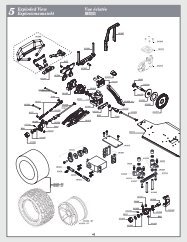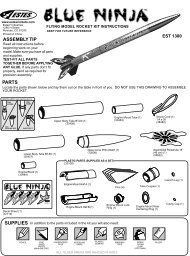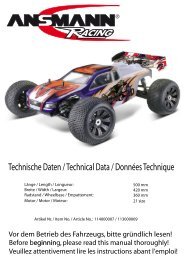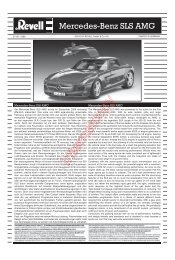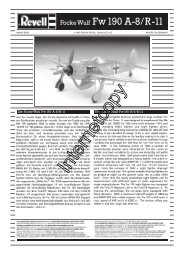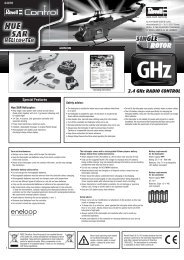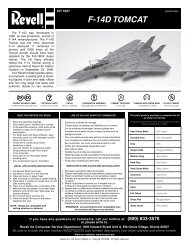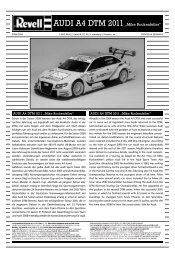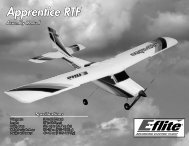WARNING: CAUTION: The performance of this ... - HobbyTown USA
WARNING: CAUTION: The performance of this ... - HobbyTown USA
WARNING: CAUTION: The performance of this ... - HobbyTown USA
Create successful ePaper yourself
Turn your PDF publications into a flip-book with our unique Google optimized e-Paper software.
RACING<br />
TURN FIN – <strong>The</strong> turn fi n is what holds the boat in the corners<br />
at speed. <strong>The</strong> turn fi n can also be tilted back and forth to<br />
change the way the boat handles. Tilting the fi n up (positive)<br />
causes the boat to run tighter on the water and tilting it down<br />
(negative) causes it to run looser.<br />
FIBERGLASS – Like the other parts <strong>of</strong> the boat you can<br />
gain some <strong>performance</strong> by working the bottom <strong>of</strong> the boat.<br />
You can fl at sand the sponson bottoms dead fl at to gain<br />
more speed as well as roughen the surface to release any<br />
surface tension the smooth paint causes. We like to fl at sand<br />
the bottom <strong>of</strong> the sponsons and then scuff them with a red<br />
scratch pad. <strong>The</strong> scratched surface keeps the water from<br />
clinging to the smooth, painted surface, allowing more boat<br />
speed. It’s a great tuning secret.<br />
PROPELLER – <strong>The</strong> propeller is the most important part<br />
<strong>of</strong> your boat. It is responsible for the thrust, traction,<br />
acceleration, speed and handling <strong>of</strong> your UL-1. Your UL-1<br />
Superior can use both low and high lifting propellers as well<br />
as others. When you are testing your boat, you are going to<br />
want to use a prop that allows you the longest runtime and<br />
best speed. This propeller might or might not be the one you<br />
use when you are racing. Remember a Fast Electric RC boat<br />
race only takes a few minutes so the prop you might use<br />
for racing could be too hard on your electric components<br />
for general operation. During normal operation you are likely<br />
to run the boat much longer so be careful not to over prop<br />
your boat. To check to see if a prop is too much load for your<br />
electronics run the boat for one minute. Bring it in and check<br />
the temperatures <strong>of</strong> both the ESC and the motor. If they are<br />
hot or you cannot hold your fi nger on either part for more<br />
then 5 seconds, you are over propped.<br />
AQUACRAFT GRIMRACER PERFORMANCE PROPS<br />
FOR THE UL-1 SUPERIOR<br />
AQUB9720 40x52/3 Metal Prop (3-Blade)<br />
AQUB9755 L38x55 Metal Prop<br />
AQUB9760 L40x57/3 Metal Prop (3-Blade)<br />
GET ON THE CLOCK AND MILLING ON THE COURSE:<br />
Getting on the clock is a term we use to get our boats ready<br />
for the start <strong>of</strong> the race. In RC boat racing we use rolling<br />
starts and part <strong>of</strong> the fun is milling the boat, or the time we<br />
spend getting on the clock. Timing is everything and your<br />
boat has to be dependable enough to mill well and go fast<br />
enough to win the race.<br />
<strong>The</strong> start <strong>of</strong> an FE RC boat race is typically broken down into<br />
three sections. Total clock time is 60 seconds and broken<br />
down into the following: Preparation time, 60 to 30 seconds.<br />
This is what we call “get ready” time and lasts for 30 seconds.<br />
Next is launch time, 30 to 11 seconds. This is the time when<br />
boats are launched and must be up and running. Last is “No<br />
Launch” time, 10 to 0 seconds. Boat cannot be launched<br />
after <strong>this</strong> time. This is also the point where the boats are<br />
milling, picking lanes and ready for the start.<br />
DRIVING A LANE:<br />
In RC boat racing our boats race around an oval course. A<br />
lane is the distance outside the buoys that is approximately<br />
the width <strong>of</strong> our boat. If there is a boat around yours, you<br />
have to hold your lane as you are driving next to it. If you are<br />
clear <strong>of</strong> any other boats, you can choose to run your boat in<br />
any lane you like. Depending on the boat setup some boats<br />
run faster on an inner or outer lane.<br />
PASSING:<br />
Passing another boat properly takes preparation and power. If<br />
you are in an outside lane and the boat you want to overtake<br />
is to your inside, you’re going to have to give that boat some<br />
room before overtaking the lane. Make sure you have AT<br />
LEAST 3 boat lengths before overtaking that boat’s lane. Truth<br />
is it’s best to have doubled that distance to avoid drawing an<br />
infraction. It is best to stay with the lead boat and hunt out his<br />
or her weaknesses on the racecourse. If they have a habit<br />
<strong>of</strong> going wide <strong>of</strong>f buoy 6, take note. If you get the chance,<br />
sneak in behind them and try to overtake them on the inside.<br />
Remember, if you race your opponent cleanly, they will likely<br />
return the favor as you are now inside their boat.<br />
8



